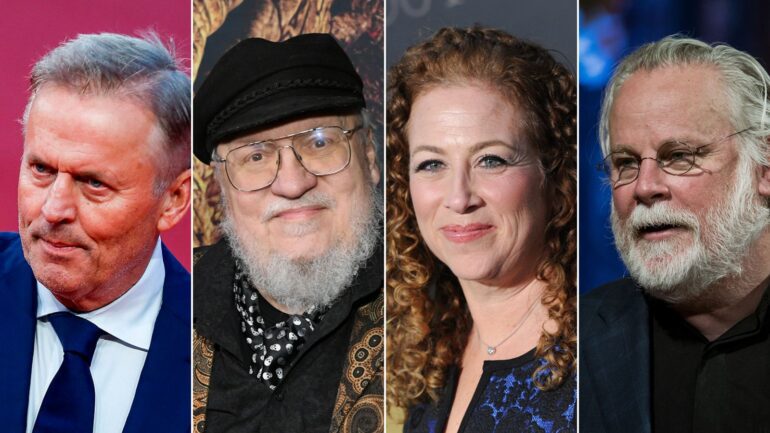TL;DR:
- OpenAI faces copyright lawsuits from figures like Sarah Silverman and Paul Tremblay in California and authors like George R.R. Martin in New York.
- Allegations claim OpenAI used its creative content without permission for training its AI, violating the U.S. Copyright Act.
- OpenAI’s defense focuses on the non-similarity of AI outputs, fair use, and vicarious liability.
- Plaintiffs argue that substantial similarity is irrelevant due to direct copying claims.
- OpenAI will have an opportunity to respond before the court’s ruling.
Main AI News:
In the rapidly evolving landscape of generative AI, a swarm of copyright disputes has recently inundated courtrooms across the nation, with OpenAI squarely in the crosshairs. Prominent figures such as the multi-talented Sarah Silverman and renowned author Paul Tremblay have joined forces as plaintiffs in California, while literary luminaries like George R.R. Martin and John Grisham have taken their grievances to the courts of New York. These legal skirmishes allege that OpenAI brazenly harnessed their creative works without proper authorization to train their generative AI tool, an action that purportedly violates the U.S. Copyright Act.
OpenAI, however, isn’t taking these allegations lightly. In a strategic move, the organization endeavored to dismiss a significant portion of claims in the Silverman and Tremblay cases, citing various justifications. Firstly, they argued that the Copyright Act shields ideas, facts, and language rather than individual expressions. Secondly, they asserted that the plaintiffs couldn’t substantiate the claim that the outputs generated by OpenAI’s extensive language model (“LLM”) tool closely resembled the original content used for its training. Lastly, OpenAI contended that any usage of copyright-protected content by their tool should fall under the umbrella of fair use, thus immunizing them from liability under the Act.
Notably, the plaintiffs swiftly retaliated, highlighting an interesting facet of OpenAI’s defense strategy. While OpenAI sought to dismiss a substantial portion of the Silverman and Tremblay claims, they conspicuously spared the plaintiffs’ claims of direct copyright infringement, opting to address them at a later stage of the proceedings. OpenAI’s arguments, in this case, revolved around the notions of vicarious liability and failure to establish a claim under Section 1202(b) of the Digital Millennium Copyright Act (DMCA). They emphasized that the plaintiffs had not adequately expounded on how ChatGPT’s outputs correlated with the works of the plaintiffs. Merely asserting that the output was “based upon” another work, OpenAI argued, was insufficient.
OpenAI briefly alluded to the fair use defense, suggesting that the courts should adapt this defense to accommodate the ever-evolving landscape of technology. They hinted at the possibility that creating copies of a work to develop a new, non-infringing product could be considered fair use. OpenAI staunchly rebuffed the plaintiffs’ claims that they possessed the right and ability to control the output of the OpenAI Language Models and had financially benefited from it, deeming these assertions insufficient to establish the remaining elements of the claim.
In addressing the DMCA claim, OpenAI refuted the plaintiffs’ allegations that copyright management information was removed during the training process of the LLM tool. They contended that the plaintiffs had not presented plausible allegations that OpenAI had intentionally concealed infringement within its process. OpenAI further argued that the plaintiffs’ state statutory claims for unfair competition, negligence, and unjust enrichment faltered, as they were either contingent on other claims or precluded by the Copyright Act.
The plaintiffs counterargued, asserting that the issue of substantial similarity was irrelevant in the context of a direct copyright infringement claim, particularly when there was evidence of direct copying. They contended that their allegations of direct copying by OpenAI rendered the substantial similarity test moot. Additionally, they argued that the fair use defense should not be resolved at this stage of the case. They emphasized that the Copyright Act primarily aimed to grant rights to authors rather than safeguarding users of authors’ works.
The plaintiffs also outlined three distinct theories of direct infringement in support of their vicarious infringement claim, encompassing “training” or “input” infringement, “model” infringement, and “output” infringement. They asserted that OpenAI had the authority to halt infringing activities since they controlled the training data, the LLMs themselves, and ChatGPT and had profited from them.
Regarding the DMCA claims, the plaintiffs argued that their works indeed contained copyright management information (CMI) and that OpenAI had deliberately removed it. They asserted that their state-law statutory claims were not preempted, as they centered on the unauthorized use of their works rather than the replication of said works. Finally, they maintained that their common-law claims for negligence and unjust enrichment were well-founded, citing precedent where such claims had coexisted with copyright infringement claims.
As this legal saga unfolds, OpenAI will have the opportunity to present a rebuttal before the court’s eventual ruling. Observers eagerly anticipate the additional arguments that will emerge, knowing that this case may set a precedent for the contentious issue of whether LLMs can continue to draw from others’ creative content for training without compensating the original rights holders.
Conclusion:
This legal battle underscores the growing challenges surrounding AI’s use of copyrighted content. Depending on the court’s decision, it could potentially impact the way AI models like OpenAI’s GPT-3 access and utilize copyrighted material, shaping the future of the market for AI-generated content and its compliance with copyright laws.

